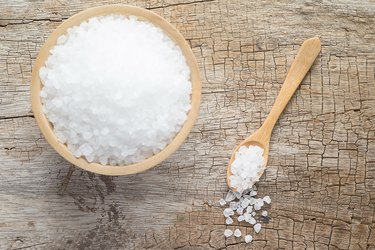
Salt might make your food taste better, but is it worth the health risks? In the context of a healthy diet, 400 milligrams of sodium is typically not a concern. However, it is implicated as a factor in hypertension, too much sodium in your diet contributes to unnecessary health risks.
Tip
Whether or not 400 milligrams of sodium is "bad for you" depends on your daily intake of this nutrient. Maximum daily value for sodium is 2,300 milligrams — or less, if you have certain medical conditions.
Video of the Day
While completely eliminating sodium from your diet is neither healthy nor advisable, moderation in sodium intake ensures that you get enough of this necessary nutrient without putting your health in jeopardy.
Video of the Day
Know the Recommendations
According to the American Heart Association, the maximum daily value for sodium is 2,300 milligrams, based on a 2,000-calorie diet. However, the AHA also states that ideally, adults should limit their intake to 1,500 milligrams per day.
A single food source that provides 400 milligrams of sodium may not be a good choice for you —depending on your diet as a whole — if you've been advised by your doctor to limit sodium.
Follow Daily Sodium Intake Guidelines
The Dietary Guidelines for Americans 2015-2020 points out that while most people benefit from consuming less than the recommended daily value of sodium, decreased intake is particularly beneficial for people with chronic kidney disease or high blood pressure.
For these groups, the recommended upper intake is 1,500 milligrams daily. Although 400 mg of salt is certainly within the bounds of healthy daily intake, a single serving of food that provides this amount of sodium packs more than 26 percent of the recommended amount for those at risk.
There are online tools if you are looking for a sodium to salt calculator, such as one from the Heart Foundation, which you can find in the Resources section.
Identify Salt Sources
Sodium in food doesn't just come from your salt shaker. As the Centers for Disease Control and Prevention (CDC), points out, more than 70 percent of the sodium consumed by Americans comes from restaurants and processed foods.
Sodium is consumed mainly from grains, meat, poultry soups and sandwiches, according to the CDC. Sodium can be found in many other processed foods including frozen pizza and even breakfast cereals.
When evaluating the healthfulness of a particular food, consider sodium content listed on the nutrition label. Also, be aware that many packaged foods contain more than one serving.
According to the CDC, in order for a food product to be considered "low sodium," it can't contain more than 140 milligrams of sodium per serving. "Very low sodium" foods contain 35 milligrams or less.
Get Enough Salt
Sodium plays an important role in your body's healthy function, contributing to nerve health, proper fluid balance and muscle contraction and relaxation.
According to the American Heart Association, that equates to less than 500 milligrams per day — less than 1/4 teaspoon. It isn't difficult to take in enough sodium to meet your body's basic needs.
If you're concerned about sodium in your diet, consult with your doctor or a registered dietitian, particularly if you are at increased risk for high blood pressure.
- U.S. Department of Health and Human Services: "Dietary Guidelines for Americans 2015-2020"
- American Heart Association: "How Much Sodium Should I Eat Per Day?"
- Centers for Disease Control and Prevention: "Get the Facts: Sodium and the Dietary Guidelines"
- Heart Foundation: "Sodium and Salt Calculator"
Was this article helpful?
150 Characters Max
0/150
Thank you for sharing!
Thank you for your feedback!